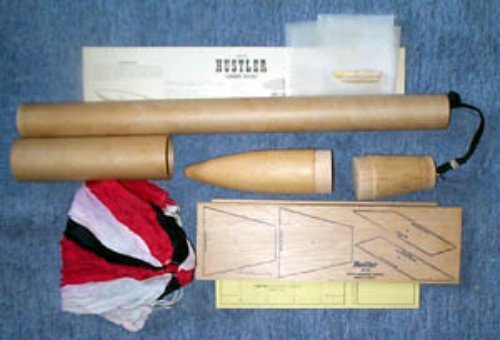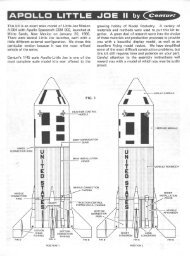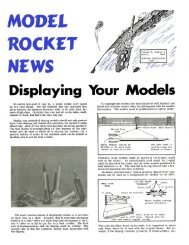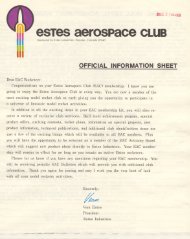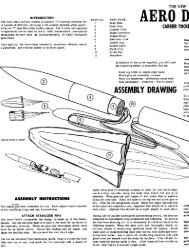You also want an ePaper? Increase the reach of your titles
YUMPU automatically turns print PDFs into web optimized ePapers that Google loves.
Cloning the Hustler (Centuri KF-10)<br />
-----------------------------------<br />
Stefan Jones<br />
September 30, 2003: This is an updated version of an earlier document. I've<br />
since completed and flown my "Hustler" clone.<br />
Here it is on the day of its first (at at this time, only) flight:<br />
http://www.io.com/~stefanj/hustler_on_the_roof.jpg<br />
http://www.io.com/~stefanj/posed_with_hustler.jpg<br />
I flew it with an Aerotech RMS 40/120 case with a F22J-5 reload. The flight was<br />
as good as they come. Once the supply of reload kits loosens up I'll fly it with<br />
a larger motor.<br />
I've also built and flown a clone of the Aero-Dart, whose construction is<br />
virtually the same as the Hustler.<br />
http://www.io.com/~stefanj/aerodart.jpg<br />
---------------------------<br />
The "Hustler" was one of Centuri's early high power kits. It is a payload model,<br />
with an enlarged payload section that the catalog copy suggested could be used<br />
for cameras, biological speciments, electronic payloads and the like. It has the<br />
rakish look favored by Centuri in the late 60s. It's not a big model by today's<br />
standards, and doesn't use any advanced techniques (e.g., through the wall<br />
construction). But I like its looks and thought it was worthy of cloning.<br />
The model was introduced around 1965, and was designed to fly on the black<br />
powder F motors (Hercules, later MiniMax) that Centuri sold through 1971. The<br />
Hercules last appeared in the 1971 catalog; the recommended motors there<br />
included the new Enerjet composite motors.<br />
The Hustler also appears in a color photo on the inside back cover of the 1969<br />
and 1971 catalogs. It's visible behind Leroy Piester. The model has a very<br />
snazzy black, orange, and white paint-job, with the usual odd Centuri roll-bar.<br />
TUBES<br />
The Hustler used the old Centuri 1.75" ID and 2.25" ID heavy-duty tubes for the<br />
body and payload section, repectively. The catalog lists the wall thickness as<br />
.045", making the outside diameters 1.84" and 2.34" respectively. The reported<br />
lengths are 22" and 8" respectively. Sean Lannan, who has an original kit, notes<br />
that the body tube is a bit longer (22.1").<br />
The Aerotech "1.9" tube (OD 1.88") is a close match for the ST-175 body tube.<br />
Totally Tubular sells this tube, along with coupler stock.<br />
For the payload section, you might find a piece of FSI's "RT-22" tubing, which<br />
is an exact match dimensionally. Firefox Industries sells a tube that is<br />
supposedly of these dimensions, as well as a body tube and coupler and nose<br />
cone. I was fortunate enough to get a length of the original tubing. (Thanks<br />
Len!)
A slightly "downscale" and oddly-proportioned Hustler could be made from a BT-60<br />
body and a BT-70 payload tube. Estes made a balsa adapter to join these tubes<br />
(TA-6070), and BMS stocks the BT-70AJ nose cone. I am making two of these<br />
clones. To make the cones and transitions more proportional, I extended the<br />
shoulders with a bit of BT-70 coupler. This let me fill in (using balsa putty)<br />
1/4" of the cone and transitions' balsa shoulders, effectively lengthening the<br />
pieces.<br />
ENGINE MOUNT<br />
The Hustler had a mount for a 1.125" diameter x 7.75" long MiniMax engine.<br />
In early versions, the mount consisted of two hardwood centering rings and a<br />
"stop." There was no motor tube! I don't know what the stop consisted of;<br />
perhaps a centering ring with a smaller-diameter center hole.<br />
Later versions of the Hustler (and probably other MiniMax kits) had a motor<br />
mount very similar to a modern 29mm motor mount. This mount had a 1" long black<br />
"fish paper" thrust ring, and a 8" long mount tube.<br />
The centering rings were 3/4" thick balsa, at least in some versions. To judge<br />
from my Aero-Dart (circa 1969), some kits thick wound-fibre rings. My full-scale<br />
Hustler clones have balsa centering rings made from a stack of three 1/4" balsa<br />
rings made by BMS.<br />
The catalog copy states that the Hustler came with adapter for the MiniMax F<br />
motors. This was, apparently, a length of black fish paper tubing.<br />
There was no engine hook. Motors were probably friction-fitted to prevent<br />
ejection. This has worked fine in my flights to date.<br />
FINS<br />
The stock Hustler uses 3/16" balsa fins. The fin patterns were printed, two<br />
pieces per fin, directly on the balsa stock. (If the fin stock included with my<br />
"Aero-Dart" is typical of MiniMax kits, then the stock is VERY hard, highquality<br />
C-grain balsa.)<br />
A scan of an original sheet was kindly provided by Sean Lenann, who notes that<br />
the root edge on a properly scaled print-out should be 3.8" long. (The sheets<br />
are 4" wide.)<br />
In the original kit, the fins were glued directly to the body tube; fabric<br />
("Silray") reinforcements were then glued or doped over the fin/tube joints.<br />
On my clone, I roughed up the glossy body tube surface a bit and used "fin<br />
rivets." I decided to use lightweight fiberglass for reinforcements, and added<br />
strips of fiberglass to the leading and trailing edges. I used 2 Hour epoxy to<br />
laminate the fiberglass to the balsa.<br />
NOSE CONE<br />
The nose cone is balsa, overall length 7.85" with a 6.9" visible section.<br />
If my Aero-Dart nose is to judge, the balsa used was very hard and dense.
A cone for the payload section is available from Firefox Industries, but there's<br />
no guarantee how close a match it is to the original shape. I turned my own<br />
cones for the payload tube, using balsa stock from BMS.<br />
TRANSITION<br />
According to the catalog, the balsa transition section had a 2.1" long visible<br />
section. I measured an actual example (Thanks, Sean!) and tt was almost exactly<br />
2 3/8" long.<br />
I turned the transitions for my clones from 3" balsa stock. Because the original<br />
shoulder was rather short, I added 1.5" of coupler stock to the narrow end. This<br />
makes for a much more secure fit, with less of a chance of torquing.<br />
LAUNCH LUGS<br />
Centuri used glossy fibre 3/16" launch lugs for its high-power kits. I did some<br />
guesstimation and determined that the Aero-Dart had 2" long lugs. The Hustler<br />
probably used these as well.<br />
Some Centuri catalogs offered aluminum 3/16" lugs. Early Hustlers may have used<br />
these.<br />
The lugs were mounted on balsa stand-offs, to allow the launch rod to clear the<br />
payload section. I have not seen patterns for these, but based on the<br />
illustrations in the plan, they're probably flattish trapezoids, with a height<br />
of 1/2", top 2" wide, base 3" long.<br />
RECOVERY SYSTEM<br />
The catalog notes that the Hustler used a 24" hemispherical silk parachute with<br />
red, white, and black panels. For my clone, I used a 21" parachute made from the<br />
canopy of a toy umbrella.<br />
The original kit came with the motor mount and shock cord installed. If it's<br />
anything like my Aero-Dart, the Hustler's shock cord consists of a heavy duty<br />
black elastic strip (1/4" or so) plus a braided wire "check cord." These run in<br />
parallel; the check cord is a bit longer than the elastic.<br />
By modern standards, the harness installed in my Aero-Dart is WAY too short for<br />
comfort. It almost guarantees destructive "snap back."<br />
For both my Aero-Dart and Hustler clones, I used a 12" kevlar anchor cord and a<br />
three-yard piece of black 1/4" elastic. I tied the anchor cord to the motor<br />
mount, passed it through a notch on the inner surface of the centering ring, and<br />
added a barrel swivel. After the model was finished, I shook the model until the<br />
cord and swivel fell through the motor mount tube; I tied the elastic cord to<br />
the swivel and fed it back through the mount tube and out of the front for<br />
attachment to a screw-eye on the transition section.<br />
PAINT SCHEMES<br />
A variety of paint schemes are shown in the catalogs. None appear to be<br />
official. I chose the scheme shown in the only actual photos of the Hustler:<br />
* White main body tube<br />
* Red or orange payload tube
* Two black fins, two white fins<br />
* Black nose cone and transition<br />
The picture shows a roll bar, but with not enough detail to determine the exact<br />
dimensions. I made a temporary roll bar with 3/4" PVC tape. The photo model also<br />
shows a black Centuri logo.<br />
OTHER STUFF<br />
According to accepted history Centuri's big BP motors used tooling and designs<br />
made by Coaster, a hoary pioneer of large scale rocketry. However, there are<br />
clues that Leroy Piester made large BP motors very early on; one Centuri<br />
newsletter states that he made "MiniMax" motors in the mid 1950s!<br />
In any case, Centuri offered an F motor (F11-3, old rating system) in its 1964<br />
catalog. The 1965 catalog offered end-burning Atlas and port-burning Hercules<br />
motors, in D - F classes. Both were shown as having 1.0625" casings.<br />
The Mini-Max name was in use by '67 at least (there's no '66 catalog to refer<br />
to). Case diameter was shown as 1.125".<br />
The motor offerings changed almost yearly until Mini-Max disappeared in 1971.<br />
There tended to be several low-impulse motors (long-burning motors for the<br />
"Jaguar", "Scorpion" and "Explorer" kits) and one or two high-impulse motors<br />
(F100-like motors, for the "Explorer," "Lil' Hustler", "Aero-Dart" and<br />
"Hustler"). For a few years, D, E, and F motors were all offered.<br />
It must have been hell keeping up with the changes. One year Centuri offered a<br />
"E7" (incidentally, almost identical to the Estes E9 except for the heavier<br />
casing); the next two, an "E15," with much higher total impulse.<br />
I've heard, from several anecdotal sources, that Mini-Max motors were horribly<br />
unreliable. Al Andrake, of AAA Model Aviation Fuels, told me that Irv Waite<br />
(RDC, Enerjet) determined that part of the problem was the depth sensor on the<br />
Mini-Max motor press. The machine pounded three motors at once, but the sensor<br />
only checked the depth of the ram in one of the cylinders. When the ram reached<br />
the proper depth, the hydraulic pressure to all three cylinders was cut off.<br />
This meant that the other two cylinders could have improperly pressed grains.<br />
Waite's suggested improvements greatly increased the reliability of the Mini-Max<br />
motors . . . of course, Waite was also to introduce the Enerjet motors that<br />
pretty much doomed the BP line. So it goes.<br />
Mini-Max motors apparently used an igniter that consisted of a fuse-like<br />
material and some nichrome. The motors came wrapped in a glossy white wrapper<br />
with colorful printing. I don't know if this had to be removed for mounting.<br />
Since the motors were friction-fitted, this might have been necessary.<br />
If you find yourself chafing at current DOT restrictions, consider: Mini-Max and<br />
Enerjet motors were totally unmailable. You had to have them shipped, frieght<br />
collect, by Railway Express, a long-defunct shipping firm. My 1971 Centuri<br />
catalog provides estimated shipping to the East Coast starting at $5.00. (To be<br />
fair, this would have covered up to a dozen big motors.) This was a big chunk of<br />
money at the time, and Railway Express didn't deliver everywhere. I've heard<br />
that the company delivered to the door by truck, dispelling the romantic image<br />
of waiting at a depot and getting handed your package from the door of a boxcar.
A clone Hustler should fly well on a variety of composite motors. However, for<br />
full authenticity you should tap into the diminishing supply of FSI F100 or<br />
<strong>Rocket</strong>flite F101 or F50 motors, which are probably a close match for the MiniMax<br />
F97. A CATO that blows the model to smithereens could be seen as a recreation of<br />
an authentic MiniMax-flying experience.<br />
END<br />
Interesting Correspondence<br />
Re: [Old<strong>Rocket</strong>s] MiniMax Hustler: Payload tube length<br />
Date: Mon, 15 Jul 2002 6:38:09 PM Eastern Standard Time<br />
From: Sean Lannan <br />
To: Old<strong>Rocket</strong>s@yahoogroups.com<br />
Reply-To: Old<strong>Rocket</strong>s@yahoogroups.com<br />
Sent from the Internet (Details)<br />
Sorry, I should have been more specific. The total length [of the nose cone]<br />
w/shoulder is<br />
~7.85" [with a 6.9" visible section].<br />
The Hustler's length (the one I have, anyway) works out to: main tube<br />
22.1" + transition 2.5" + payload tube 8" + nose cone 6.9" + 1" for the<br />
fin tips = 40.5. This isn't the only kit Centuri gave the wrong specs<br />
for. Makes them tough to clone with out a kit to measure.<br />
I'll send you the pattern in another email. I'll be sending the plans<br />
and templates to the YORS plan site as soon as I get around to splicing The<br />
plans together.<br />
Sean


